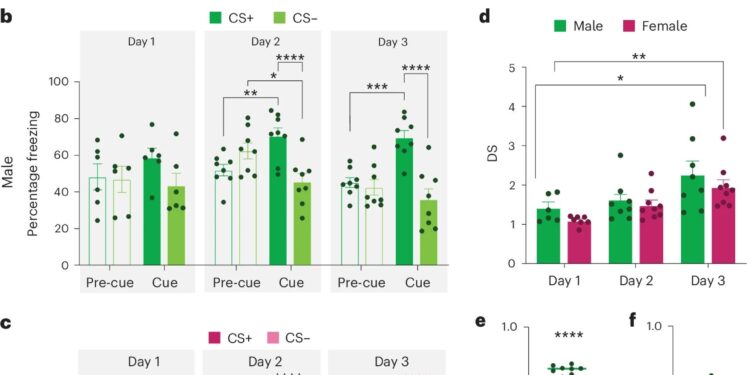Men and women are equally subject to risk-based discrimination. Credit: Neuroscience of Nature (2024). DOI: 10.1038/s41593-024-01748-7
A new study has found significant differences in how male and female mice process threats, even though they exhibit similar behavioral responses.
This finding suggests that including both male and female subjects in neuroscience research will lead to more accurate conclusions and, ultimately, better health outcomes.
Understanding how sex influences brain function may help explain why men and women develop certain psychiatric disorders at different rates or with different symptoms, the researchers said.
“Unless we thoughtfully and rigorously integrate sex into biomedical research, a large portion of the population is at risk of being underserved by scientific knowledge,” said Rosemary Bagot, an associate professor at McGill University and Canada Research Chair in Behavioural Neurogenomics, who led the study.
“Our work shows that gender is an important variable to consider, even if initial observations don’t necessarily show clear gender differences,” Bagot said. “If men and women use different brain circuits to solve similar problems, they may be differently vulnerable to stress and respond differently to treatments.”
How brain circuits process threats and signals
The study focused on two related brain circuits and their roles in processing information about threats and the signals that predict them.
The researchers trained mice to recognize a sound that signaled threat and another that signaled safety. By observing brain activity, the team observed how communication between different brain areas processed these signals. They then temporarily disabled each brain connection to see how it affected the mice’s reactions, helping them understand how the brain handles threats.
“We found that although male and female mice respond similarly to threats, the brain circuits underlying these responses are not the same,” Bagot said.
In female mice, a connection between two specific brain areas (the medial prefrontal cortex and the nucleus accumbens) played a key role. The study found that in male mice, a different connection (between the ventral hippocampus and the nucleus accumbens) was more important for handling the same situation.
Until now, it was thought that similar behaviors led to similar brain functions. Now, researchers are studying how sex affects the brain circuits that process threats, focusing on the role of sex hormones and different learning strategies.
The work is published in the journal Neuroscience of Nature.
More information:
Jessie Muir et al., Sex-biased neural coding of threat discrimination in nucleus accumbens afferents leads to suppression of reward-seeking behavior, Neuroscience of Nature (2024). DOI: 10.1038/s41593-024-01748-7
Provided by McGill University
Quote:Mice study finds sex differences in how brain handles threats (2024, September 12) retrieved September 12, 2024 from
This document is subject to copyright. Apart from any fair dealing for the purpose of private study or research, no part may be reproduced without written permission. The content is provided for informational purposes only.



